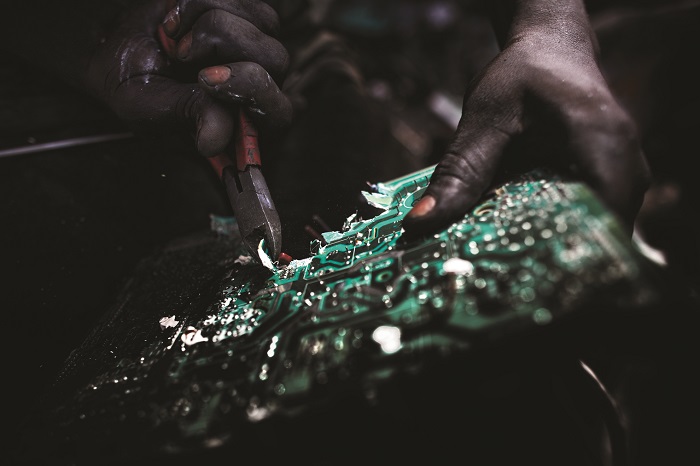ISABEL RUBIO ARROYO | Tungsteno
According to the United Nations, over 50 million tonnes of electronic waste are discarded every year. That's more than the weight of all the commercial aircraft ever made or enough Eiffel Towers to cover the entire island of Manhattan. When this e-waste is not treated properly, it can pollute the environment, disrupt the food chain and affect people's health. We look at how this waste can affect food and to what extent its consumption poses a health risk.
A tsunami of e-waste
Asia is the continent that generates the largest volume of e-waste (some 24.9 million tonnes), according to the United Nations. It is followed by the Americas (13.1 million tonnes), Europe (12 Mt), Africa (2.9 Mt) and Oceania (0.7 Mt). "With mounting volumes of production and disposal, the world faces what one recent international forum described as a mounting ‘tsunami of e-waste’, putting lives and health at risk," says Tedros Adhanom Ghebreyesus, director-general of the World Health Organization (WHO).
E-waste often ends up in large landfills in the world's poorest regions. For example, in Agbogbloshie, an urban area in Ghana that houses tons of e-waste from Europe, scores of workers sort through technological products such as washing machines, cookers, vehicles, mobile phones and computers. If these devices are not handled properly, they can pollute the environment and affect human health.

Some 50 million tonnes of e-waste is discarded every year, according to the United Nations. Credit: Andrew McConnell / Luis Valtueña International Prize.
Contaminated eggs and tuna
Various studies have found that the heavy metals in this type of landfill generate significant contamination of the soil and atmosphere. The breaking down of discarded electronic components and the burning of plastics to recover metals emit pollutants that also affect animals. For example, eggs from chickens in the Agbogbloshie slum contain dangerous levels of dioxins and polychlorinated biphenyls, among other harmful substances.
As researcher Jindrich Petrlik explains, dioxins are "extremely toxic in very small quantities". This is confirmed by Marie-Noel Brune Drisse, lead author of the WHO report Children and digital dumpsites: "A child eating a single chicken egg from Agbogbloshie will consume 220 times the tolerable daily intake of chlorinated dioxins set by the European Food Safety Authority."
Heavy metals from e-waste can also find their way into rivers and oceans and, once there, enter the food chain. A study published in the journal Science of The Total Environment indicates that tuna caught in African waters have high concentrations of different metals, including mercury and lead. The authors conclude that the consumption of contaminated fish poses a health risk to local populations and consumers in other countries.
Fish caught in African waters enters the circuits of world trade and can be sold anywhere, according to Alba Ardura Gutiérrez, a biologist and post-doctoral researcher in the area of genetics at the University of Oviedo: "If African heavy metal contamination reaches tuna in the open sea through river plumes and the food chain, Europe could be consuming heavy metal contamination through the ingestion of marine species caught in African waters."

If e-waste is not handled properly, it can pollute the environment and disrupt the food chain. Credit: Andrew McConnell / Luis Valtueña International Prize.
Eating heavy metals and their health risks
Workers who recycle electronic waste are exposed to multiple toxic metals. These metals can be breathed in, absorbed through the skin or eaten. The levels of metals found in food depend on many factors, including the quantities of these elements found in the air, water and soil used to grow the crops, according to the US Food and Drug Administration (FDA).
More studies are still needed to understand how these metals accumulate in the food chain and to what extent their consumption currently poses a health risk. When too much metal enters the human body, it can cause poisoning, according to MedlinePlus, a service of the US National Library of Medicine. Heavy metal poisoning can lead to serious health problems, including organ damage, behavioural changes and difficulties with thinking and memory.
In fact, some people—such as pop singer Robbie Williams—have suffered severe mercury and arsenic poisoning and near death after following a strict fish diet. Other foods that may contain high levels of arsenic, according to the European Food Safety Authority, include rice, cereal products and even drinking water. In some countries, such as Bangladesh, millions of people are at risk of exposure to high concentrations of this naturally occurring element in the earth's crust. More research into the extent of the heavy metal problem is urgently needed in a context in which e-waste is on the rise: according to the United Nations, 74 million tonnes of e-waste will be produced by 2030.
· — —
Tungsteno is a journalism laboratory to scan the essence of innovation. Devised by Materia Publicaciones Científicas for Sacyr’s blog.
